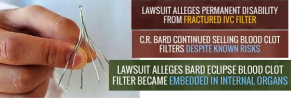There have been increasing reports of complications from IVC (inferior vena cava) filters, which are supposedly designed to prevent blood clots from traveling to the lungs. A recent study links the IVG filters to thrombosis, claiming that there is a high risk of the devices puncturing internal organs. As opposed to the manufacturer’s claims that the retrievable devices are designed to prevent blood clots from traveling to the lungs, the filters have been found to fracture inside the body, thus raising the risk of clots and Bard G2 IVC side effects when they are not retrieved for prolonged periods of time.
The University of Rochester Medical Center researchers, who conducted the study published in JACC Cardiovascular Interventions, warn that unretrieved IVC filter causes 2.6-4% of the total cases of deep vein thrombosis.
What are IVC Filters?
In simple words, these are spider-shaped devices placed in the vena cava. These filters are designed to “catch” clots that may break and move freely in the body, blocking them from traveling to different parts of the body, including lungs, causing pulmonary embolism.
However, problems have been reported with retrievable IVC filters, where the displaced devices resulted in severe and fatal injuries. Some of the most severe repercussions of the displacement is the puncturing of the vein and the device moving to the heart or lungs, resulting in fatal consequences.
There have been increasing reports of migration, perforation, and fracturing caused of these retrievable devices. Retrievable filters are designed for patients at a high risk for pulmonary embolism. Since these are retrievable devices, they are removed once the risk has reduced and the filters are no longer needed.
However, if the devices aren’t removed, there is a severe risk of Bard G2 IVC side effects. Moreover, the longer a device remains within the body, the tougher it is to remove, causing severe complications.
The FDA issued an advisory in May 2014, urging doctors to remove IVC filters once the risk of pulmonary embolism had reduced in a patient, basically in one or two months, as there is a risk of fracture and migration if the device is not retrieved, resulting in serious Bard G2 IVC side effects.
Researchers warn that patients with untreated IVC filter blood clots are at a high risk of post-thrombotic syndrome if the device is not retrieved. This risks causing disabling venous claudication, pulmonary embolism, and venous ulceration.
IVC Filter Lawsuits
Hundreds of Bard G2 IVC lawsuits have been filed on behalf of people that have suffered from the migration, fracturing, or perforation of these retrievable devices.
The first litigation was filed in 2010, when the FDA indicated having received 900 adverse event reports about the Bard G2 IVC side effects, of which 328 were about migration of the device, while 146 were about the disintegration of the components. There were 70 reports of perforation and 56 of fracturing, raising concerns of the safety of the filters.
If you or a loved one has suffered from the side effects of these devices, you may have a potential claim against the manufacturer. Our Bard G2 IVC attorney have been representing individuals who have experienced problems with these filters, where the devices have either broken or fractured or even perforated, causing potentially life-threatening injuries.
The IVG filters are unreasonably dangerous. You may be eligible for financial compensation for the pain and suffering. Our IVC filter injury lawyer is reviewing potential Bard G2 IVC filter lawsuits. Contact us or call on 1-800 632-1404 to evaluate any prospective product liability or personal injury claim for yourself, a friend, or family member.
